🏢 Introduction
In the competitive landscape of modern architecture, the selection of fenestration systems is a critical decision that impacts a building’s aesthetics, energy efficiency, and long-term value. Among the myriad options available, aluminium casement windows remain a cornerstone for high-end residential developments, luxury hotels, and commercial office blocks.
Unlike sliding systems, which rely on overlapping sashes, casement windows attach to the frame by one or more hinges at the side. This fundamental difference in mechanics allows for superior sealing performance, making them the preferred choice for architects aiming to meet stringent building codes.

Why Projects and Hotels Prefer Aluminium Casement Windows
For developers and facade consultants, the shift towards commercial aluminium casement windows is driven by a need for higher performance. In high-rise environments, wind load resistance and water tightness are non-negotiable.
🏗️ Project Experience:
We don’t just supply windows; we engineer solutions for complex environments. For instance, in the Hurtle & Co. apartment project in Adelaide, Australia, and the prestigious Banana Island Foreshore luxury residential area in Lagos, Nigeria, the developers faced a dual challenge: high acoustic requirements due to urban noise and extreme weather durability.
In both cases, we deployed our aluminium casement window system A80T. This solution balanced the need for modern, slim sightlines with the robust structural integrity required to withstand coastal winds and urban clamor.
What This Guide Covers
This article We will explore aluminium casement window specification for projects, detailed performance metrics (including NAFS rated aluminium windows), and critical selection criteria for tendering.
Whether you are comparing aluminium casement windows vs sliding windows or calculating aluminium casement window prices per square meter, this article serves as your technical handbook.
🪟 What are Aluminium Casement Windows?
Basic Definition and Structural Features
An aluminium casement window is a window unit attached to its frame by one or more hinges at the side. They are usually fitted with single or multi-point locking systems and are operated by a crank, lever, or cam handle.
The versatility of aluminium allows these windows to be designed as:
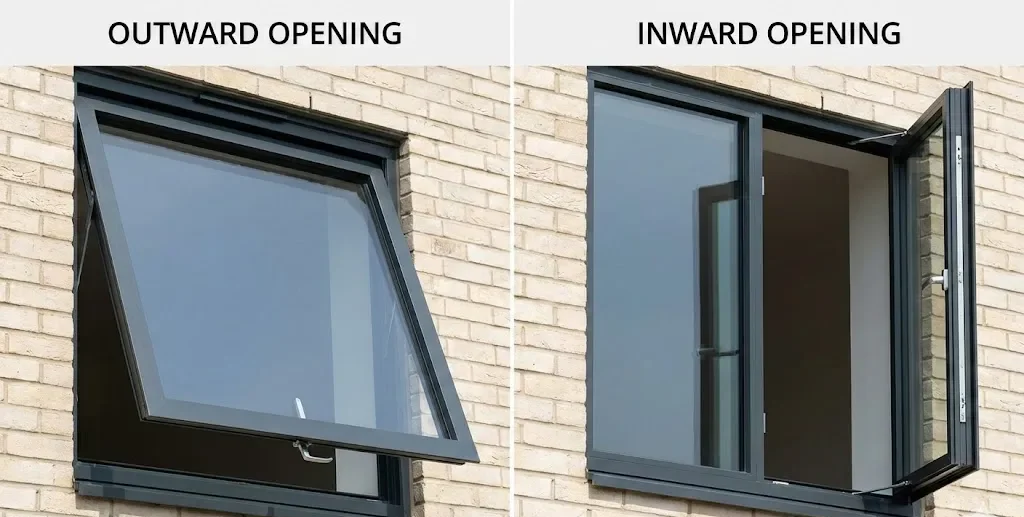
- Outward opening aluminium casement windows: The most common style, maximizing indoor space.
- Inward opening aluminium casement windows: Often used in high-rise buildings where cleaning from the inside is necessary.
To understand the broader landscape of window types and how they fit into architectural designs, you might want to read about the Types of Aluminium Windows: Styles and Features.
Working Principle
The core mechanism involves a sash that presses against the frame’s weather stripping when closed. Unlike sliding windows that rely on brush seals, the compression seal of a casement window creates a vacuum-like barrier. This structural characteristic is why energy efficient aluminium casement windows often outperform other operating types in air infiltration tests.
⚙️ System Constitution of Aluminium Casement Windows
A high-performance window is a sum of its parts. When specifying the aluminium casement window system A80T, understanding these components is vital.
1. Profiles and Structural Design
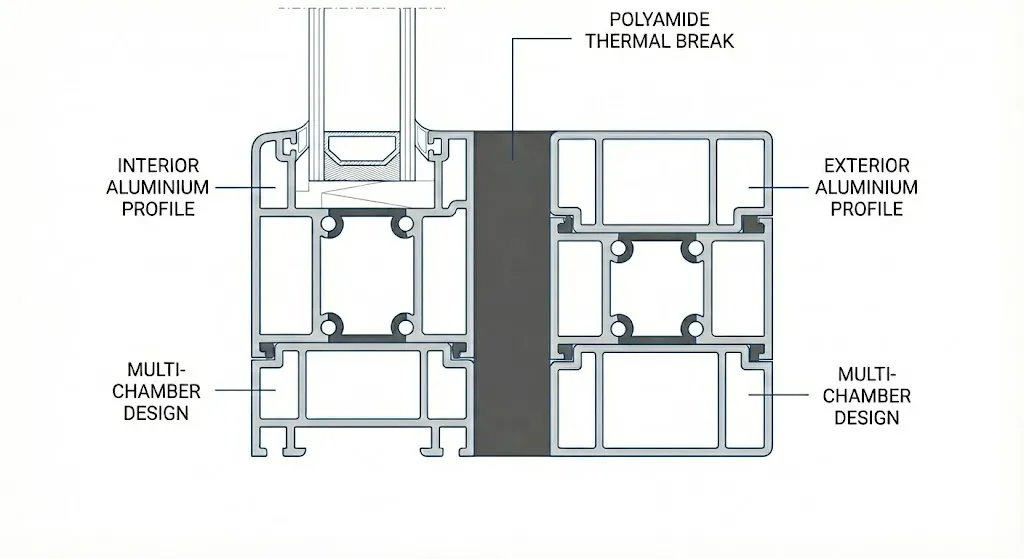
Modern projects typically require thermally broken aluminium casement windows. This involves a polyamide strip separating the interior and exterior aluminium profiles, significantly reducing heat transfer.
- Chamber Design: High-end systems utilize multi-chamber designs (isobaric chambers) to facilitate drainage and improve sound insulation.
- Finish: For projects near the coast (like our Banana Island case), surface treatment is crucial.
(To decide between finishes, refer to our guide on Anodizing vs. Powder Coating.)
2. Glass Configuration
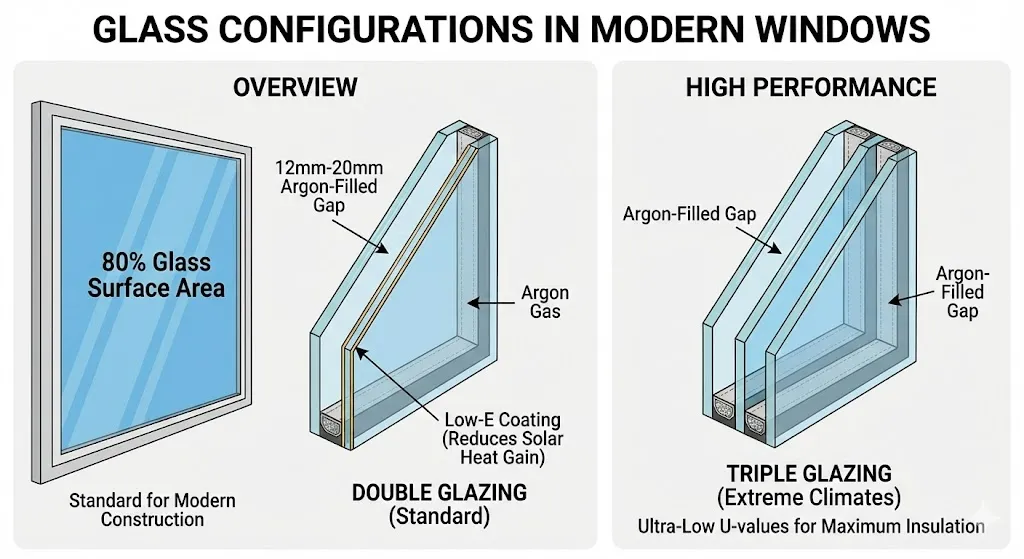
The glass makes up 80% of the window’s surface area.
- Double glazed aluminium casement windows: The standard for modern construction, typically featuring a 12mm to 20mm argon-filled gap.
- Triple Glazing: Used in extreme climates for ultra-low U-values.
- Low-E Coatings: Essential for reducing solar heat gain in hotels and offices.
3. Hardware Systems
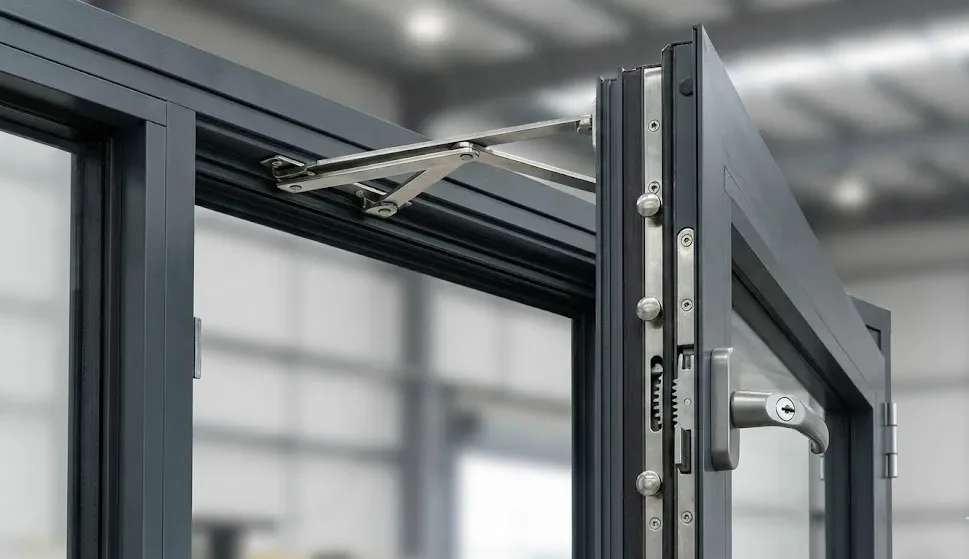
The durability of commercial aluminium casement windows depends heavily on the hardware.
- Dobradiças: Heavy-duty friction stays are required for large sashes.
- Handles & Locks: Multi-point locking mushrooms ensure the sash pulls tightly against the frame for security and sealing.
(For design inspiration, check out 7 Aluminium Door Handle Designs, as many styles translate to window hardware.)
4. Sealing and Drainage

A sophisticated hidden drainage system is often employed in the A80T system, where water is channeled out through the sub-frame, preventing backflow during storms. EPDM gaskets are used for their longevity and resistance to UV degradation.
📊 Key Performance Indicators for Engineering Projects
When drafting an aluminium casement window specification for projects, generic terms like “good quality” are insufficient. You need quantifiable data.
✅ Performance Standards
We believe in data-driven engineering. Our A80T series (covering both casement and tilt and turn aluminium windows) has undergone rigorous testing under the North American Fenestration Standard (NAFS).
- Design Pressure: Tested at approximately 1920 Pa for a 1200×1800 mm sample.
- Water Tightness: Achieved approximately 290 Pa, ensuring zero leakage even under heavy storm conditions.
- Thermal Performance: With double Low-E glazing, the whole window U-value is approximately 1.6 W/m²·K.
- Certifications: We hold NFRC certified aluminium windows status and multiple international standard certificates.
Anti-Wind Pressure

For aluminium casement windows for high rise buildings, wind load calculations must account for positive and negative pressure at specific building heights. The profile wall thickness and moment of inertia (Ix values) dictate this capability.
For a deeper dive on structural framing, see How Thick is an Aluminium Door Frame as the principles apply to sturdy window frames as well.
Airtightness and Water Tightness
The compression seal mechanism makes casement windows superior in this regard. This is critical for maintaining indoor air quality and preventing water damage in tropical climates.
Thermal Insulation (U-Value)
To meet modern energy codes (like Title 24 in California or Part L in the UK), thermally broken aluminium casement windows are mandatory.
For more on how insulation is measured, read about U-Values for Aluminium Panels.
Isolamento Acústico
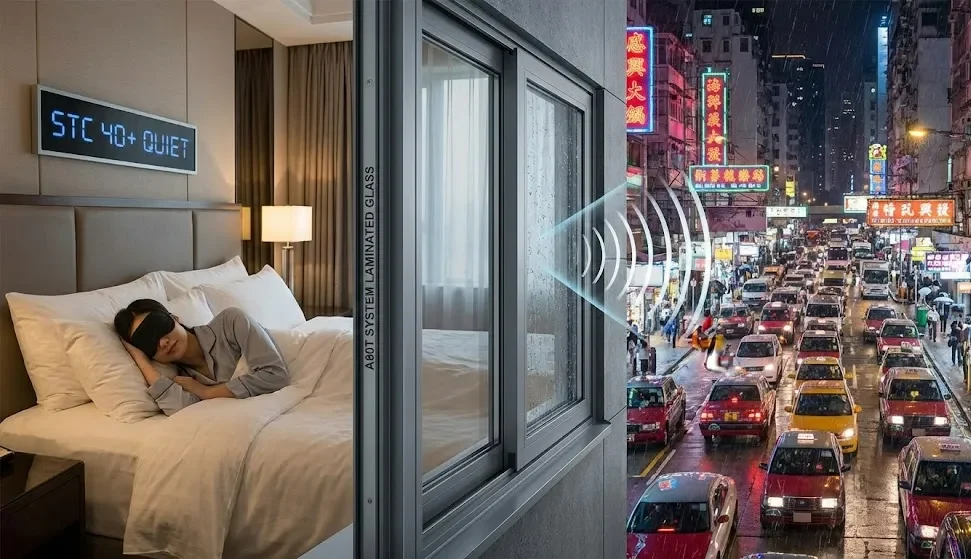
Soundproof aluminium casement windows are a top request for city hotels. By combining laminated glass with the tight seal of the A80T system, we can achieve STC (Sound Transmission Class) ratings of 40 or higher, effectively blocking traffic noise.
⚖️ Pros and Cons of Aluminium Casement Windows (Project Perspective)
Before finalizing your choice, it is helpful to compare aluminium casement windows vs sliding windows ou aluminium casement windows vs upvc windows.
✅ Major Advantages
- Ventilação superior: The sash acts as a funnel, catching passing breezes and directing them indoors—perfect for aluminium casement windows for hotels in resort locations.
- Unmatched Sealing: The harder the wind blows, the tighter the sash presses against the frame.
- Security: Hook-shaped locks embedded in the frame make them extremely difficult to pry open.
- Aesthetics: Slim sightlines offer a modern, unobstructed view.
⚠️ Potential Drawbacks
- Space Constraints: Outward opening sashes can obstruct walkways or balconies.
- Size Limits: The weight of the glass puts stress on hinges, limiting the maximum width compared to sliding systems.
- Custo: Generally, aluminium casement window prices per square meter are higher than sliding windows due to complex hardware and profiles.
For a detailed cost breakdown, refer to Aluminium Windows Price | Get Best House Rates.
🪟 Main Types of Aluminium Casement Windows
Standard Operating Modes

Inward Opening Aluminium Casement Window
Common in Europe and high-rise buildings where exterior cleaning is dangerous. They require clear space inside the room to operate.
Outward Opening Aluminium Casement Window
The standard in the UK, USA, and Australia. They are excellent for waterproofing as the sash overlap prevents rain ingress.
Advanced Systems

🔄 Tilt and Turn Aluminium Windows
A hybrid engineering marvel. The tilt and turn aluminium window can swing inward like a door or tilt the top of the sash into the room for ventilation. This combines security with airflow.
Integration with Curtain Walls
For skyscrapers, we often see aluminium casement window details for curtain wall applications. These are “floating” sashes inserted into the grid of the glass facade, providing natural ventilation without disrupting the building’s sleek exterior skin.
For more on this system, see our guide on Curtain Wall Parts: The Complete Components Guide.
📍 Typical Installation Locations
1. Residential Projects

- Bedrooms: High acoustic needs make soundproof aluminium casement windows ideal.
- Kitchens: Crank-operated casements above sinks are easy to open.
2. Hotel Projects
Aluminium casement windows for hotels require specific limiters.
- Guest Rooms: Restricted opening angles (usually 100mm) prevent falls and liability issues while allowing fresh air.
- Corridors: Fixed and casement combinations for light and smoke ventilation.
🏗️ Project Experience:
The Banana Island Foreshore project was a masterclass in location-based specification. The owners desired floor-to-ceiling glass. However, the coastal location meant salt spray was a constant threat.

We supplied the A80T system with a marine-grade PVDF coating and stainless steel 316 friction stays. This setup ensured that the aluminium casement windows vs upvc windows debate was settled: only aluminium could provide the structural strength for such large openings while resisting the corrosive environment.
3. Commercial and Office
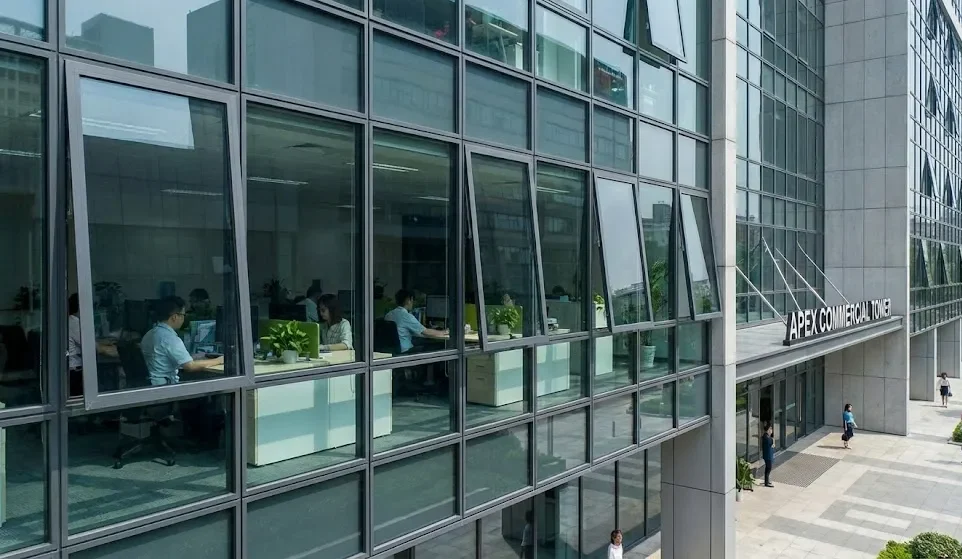
In office blocks, aluminium casement windows for high rise buildings are often automated, linked to the building management system (BMS) for night purging (cooling the building with night air).
📋 Selection Points for Developers and Hotel Contractors
When sourcing commercial aluminium casement windows, consider the total lifecycle.
1. Climate Zone and Building Height
Do you need NAFS rated aluminium windows for hurricane zones? Or energy efficient aluminium casement windows for cold climates? The A80T is versatile, but the glass spec must change accordingly.
2. Budget vs. Lifecycle Cost
While initial aluminium casement window prices per square meter might be higher than vinyl, the longevity of aluminium reduces replacement costs.
Learn more about market trends in our Aluminium Door and Window Market Insights.
3. Installation and Interface
How does the window connect to the wall? Aluminium casement window installation details must be compatible with the external cladding. Poor waterproofing at the sub-sill is a leading cause of project failure.
For installation basics, see Installing Aluminium Windows: A Step-by-Step Guide.
📝 Technical Specifications for Tendering
To ensure you get the quality you pay for, your tender documents must be precise. Avoid vague requests; instead, demand compliance with specific aluminium casement window performance requirements.

Key Specs to Include:
- Alloy: 6063-T5 or T6 architectural grade aluminium.
- Profile Thickness: Minimum 1.4mm or 2.0mm for windows, depending on aluminium casement window sizes and dimensions.
- Performance:
- Air Infiltration: < 1.5 L/s/m² (at 75 Pa).
- Water Penetration: > 300 Pa.
- Structural: > 2000 Pa (dependent on wind load).
- Certifications: Require NFRC certified aluminium windows labels for energy compliance.
🤝 Project Signals:
In many overseas bids, we actively assist the design team in writing the technical specifications. We ensure that critical parameters like U-values and aluminium casement window details for curtain wall integration are explicitly stated.
For the A80T system, we provide developers with a full technical dossier, allowing them to benchmark other suppliers against our NAFS rated aluminium windows. This transparency eliminates “apples to oranges” comparisons during procurement.
⚠️ Common Design and Installation Mistakes
Even the best aluminium casement window system A80T can fail if designed or installed poorly.
- Ignoring Maintenance Access: Designing fixed windows next to outward opening aluminium casement windows on high floors without a cleaning strategy.
- Hardware Overload: Exceeding the max weight of friction stays. Always check aluminium casement window sizes and dimensions against hardware charts.
- Thermal Bridging: Using non-thermally broken frames in cold climates, leading to condensation.
- Leakage at Miter Joints: Ensure corners are crimped and glued with high-quality sealant.
For repair advice, see Aluminium Window Frame Repair: Complete Guide.
🏁 Conclusion and Next Steps
Choosing the right commercial aluminium casement windows is a balance of aesthetics, performance, and engineering precision. The A80T system represents the pinnacle of this balance, offering soundproof, energy efficient, and structurally sound solutions for the world’s most demanding projects.
✅ Transparent Quality Assurance
For peace of mind, we have made our Quality Assurance data transparent. You can visit our product pages to view the NFRC energy labels, NAFS test reports, and ISO certifications for the A80T series.
Each project we undertake is backed by a dedicated technical team—from the initial aluminium casement window specification for projects to the final site acceptance.
If you are currently planning a residential complex, hotel, or office tower, we invite you to share this guide with your procurement and design teams.
Ready to optimize your facade?
- Contact our Engineering Team for a free consultation on the A80T system.
❓ Frequently Asked Questions (FAQ)
1. Can I mix casement and sliding windows in the same project?
Yes. It is common to use aluminium casement windows for bedrooms (for seal and soundproofing) and sliding doors for balconies (for space-saving).
2. What is the best opening restrictor for hotel rooms?
We recommend concealed restrictor arms that limit the opening to 100mm. This meets safety codes for aluminium casement windows for high rise buildings while allowing ventilation.
3. Are thermally broken aluminium casement windows necessary for all climates?
Not necessarily, but highly recommended. In hot climates, they stop heat entering; in cold climates, they stop heat escaping. They are essential for achieving low U-values and are often required by code.
4. How do I maintain the hardware?
Clean the tracks and lubricate the hinges annually. For a detailed guide, see How to Clean Aluminium Window Frames.
5. What are the standard aluminium casement window sizes and dimensions?
While we specialize in custom fabrication, standard widths range from 600mm to 900mm, and heights up to 1500mm (or higher with heavy-duty hinges).
![Apro logo - Common Aluminum Door Defects & How to Fix Them [November 2025] - APRO Logotipo da Apro](https://aprowin.com/wp-content/uploads/2024/08/Apro-logo.webp)
![A bifold glass door opens to a serene courtyard featuring a beautiful fountain at its center - Common Aluminum Door Defects & How to Fix Them [November 2025] - APRO Uma porta de vidro dupla abre para um pátio sereno com uma bela fonte no centro](https://aprowin.com/wp-content/uploads/2024/10/A-bifold-glass-door-opens-to-a-serene-courtyard-featuring-a-beautiful-fountain-at-its-center.webp)
![Sunflower view through modern black aluminum window frame - Common Aluminum Door Defects & How to Fix Them [November 2025] - APRO Vista do girassol através da moderna moldura da janela de alumínio preto](https://aprowin.com/wp-content/uploads/2024/10/Sunflower-view-through-modern-black-aluminum-window-frame.webp)
![Modern entrance featuring glass doors and awning for commercial projects - Common Aluminum Door Defects & How to Fix Them [November 2025] - APRO Entrada moderna com portas de vidro e toldo para projetos comerciais](https://aprowin.com/wp-content/uploads/2024/10/Modern-entrance-featuring-glass-doors-and-awning-for-commercial-projects.webp)
![Stylish residential project showcasing modern architecture and a beautiful pool area - Common Aluminum Door Defects & How to Fix Them [November 2025] - APRO Projeto residencial elegante com arquitetura moderna e uma linda área de piscina](https://aprowin.com/wp-content/uploads/2024/10/Stylish-residential-project-showcasing-modern-architecture-and-a-beautiful-pool-area.webp)

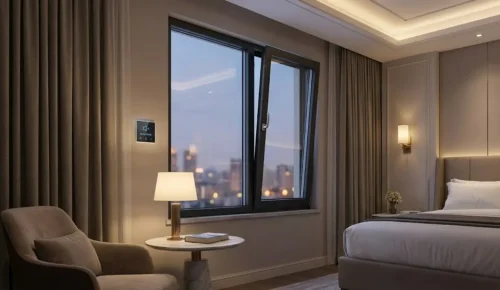
![gray door with silver handle sign that says no - Are Aluminum Doors Better Than Upvc? [Novembro 2025] - APRO porta cinza com maçaneta prateada placa que diz não](https://aprowin.com/wp-content/uploads/2024/09/gray-door-with-silver-handle-sign-that-says-no-500x280.webp)
![Portas de vidro deslizantes que abrem para uma vista da piscina em uma sala de estar - Quanto custa uma porta? Guia de instalação de portas [2025] - APRO Portas de vidro deslizantes que se abrem para uma vista da piscina em uma sala de estar](https://aprowin.com/wp-content/uploads/2024/11/Sliding-glass-doors-opening-to-a-poolside-view-in-a-living-room-500x328.webp)
![Sala de estar com portas de correr de vidro que levam a uma varanda - Tamanhos de portas padrão: guia essencial para proprietários de imóveis [2025] - APRO Sala de estar com portas de correr de vidro que dão acesso a uma varanda](https://aprowin.com/wp-content/uploads/2024/11/Living-room-with-sliding-glass-doors-leading-to-a-balcony-500x333.webp)
![Duas portas de garagem com janelas e mecanismo de porta suspensa - Como ajustar molas de porta de garagem: guia fácil [2025] - APRO Duas portas de garagem com janelas e mecanismo de porta basculante](https://aprowin.com/wp-content/uploads/2025/02/Two-garage-doors-with-windows-and-overhead-door-mechanism-500x320.webp)
![APRO logo white - Common Aluminum Door Defects & How to Fix Them [November 2025] - APRO Logotipo APRO branco](https://aprowin.com/wp-content/uploads/2024/07/APRO-logo-white.webp)